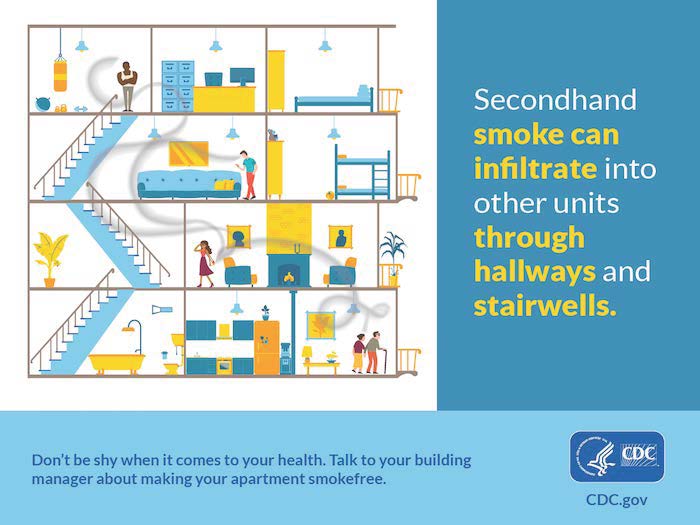Secondhand Smoke
Secondhand Smoke Poses Serious Health Threats to Children & Adults
Frequent and recurring exposure to secondhand smoke (SHS) can cause health problems such as asthma,heart disease, lung cancer, stroke, and Sudden Infant Death Syndrome, as well as worsen a chronic illness. Children, the elderly, and the disabled are especially vulnerable to exposure of SHS, yet they are the least able to avoid it. The only way to fully protect nonsmokers is to eliminate smoking in all homes, worksites, and public places.
- Tobacco smoke contains more than 7,000 chemicals, including hundreds that are toxic and about 70 that can cause cancer.
- The U.S. Surgeon General has concluded that there is no risk-free level of exposure to secondhand smoke. Breathing even a little SHS can be harmful.
- Exposure to SHS is responsible for premature deaths of 41,000 non-smokers every year in the U.S.
Secondhand Smoke Exposure in Multi-Unit Housing
The home is now the #1 source of SHS exposure.
- Smoke travels through doorways, cracks in walls, electrical outlets, ventilation systems, and plumbing.
- Opening windows and using fans does not remove SHS.
- Heating, air conditioning, and ventilation systems cannot eliminate exposure to SHS.
Are you experiencing Secondhand Smoke exposure?
If you are being exposed to secondhand smoke at home, try these tips:
- Try politely talking with whomever is smoking about the secondhand smoke and see if you can reach an agreement about how to address the problem.
- Determine if your lease or Homeowners Association (HOA) policy includes a smoke-free policy.
- Contact your property manager or HOA about the secondhand smoke.
- Keep track of how frequently you are experiencing secondhand smoke. This can be helpful information for property managers or anyone else responsible for responding to the problem.
- Chat with your neighbors to see if anyone else is experiencing the same problem. It can be helpful to work together to identify solutions for your community.
If you have tried all of the recommendations above and need further assistance, leave us a message at 408.885.4466 or email us at [email protected]. A few important pieces of information to include in your voicemail or email are your name, daytime phone number and best time to call, and the address of the multi-unit housing property where you are experiencing secondhand smoke.
Get involved and make an impact in your community!
- Join our Tobacco-Free Coalition of Santa Clara County.
- Join our Smoke-free MUH workgroup.
- Invite us to present to your organization or housing association.
- Invite us to participate in neighborhood outreach events.
- Request signage or materials for your organization or housing site.
- Obtain model smoke-free MUH policy language and advocate for adoption in your city.
If you would like to join a workgroup, request a presentation or invite us to an event; email us at [email protected]. To learn how to reduce the risk of secondhand smoke to you and your loved ones, visit Tobaccofreeca.com.
Tobacco-Free Communities
1775 Story Road
Suite 120
San Jose, CA 95122
United States

